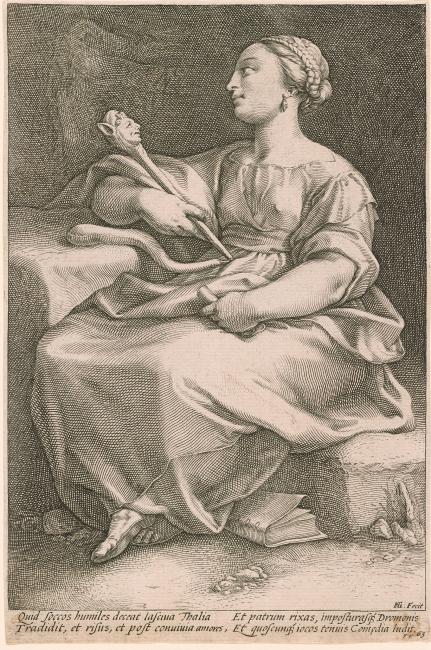
Hendrik Goltzius
1558-1617
Thalia
1592
Engraving on paper.
9 15/16 x 6 9/16 inches (253 x 166 mm)
Gift of William M. Voelkle.
2006.151
Notes
Watermark:
Designed and engraved by Goltzius, one of the greatest Dutch printmakers and draftsmen of the sixteenth century, this print is one in a series of the Nine Muses that he dedicated to his friend Jan Sadeler, the court engraver to the Duke of Bavaria in 1592. As a series, the Muses clearly represent the effects of Goltizus's journey to Rome on his representation of the human body. Compared to his earlier work, these figures display less contorted, elongated, and dynamic poses; instead, their regular proportions and heavy drapery convey an air of calm grace and stability. It has been suggested that Calliope's form recalls the second-century Roman marble sculpture of the same subject in the Vatican Museum (Strauss 1997, p. 536), and one wonders whether all of the Muses were in fact influenced by other sculptural models as well. Although their passive poses seem repetitive, closer inspection reveals a variety of expression and gesture that differentiate each Muse. This state of the prints was printed for the 1719 edition of Gerard de Lairesse's Principles of Drawing. (Andaleeb Banta)
Designed and engraved by Goltzius, one of the greatest Dutch printmakers and draftsmen of the sixteenth century, this print is one in a series of the Nine Muses that he dedicated to his friend Jan Sadeler, the court engraver to the Duke of Bavaria in 1592. As a series, the Muses clearly represent the effects of Goltizus's journey to Rome on his representation of the human body. Compared to his earlier work, these figures display less contorted, elongated, and dynamic poses; instead, their regular proportions and heavy drapery convey an air of calm grace and stability. It has been suggested that Calliope's form recalls the second-century Roman marble sculpture of the same subject in the Vatican Museum (Strauss 1997, p. 536), and one wonders whether all of the Muses were in fact influenced by other sculptural models as well. Although their passive poses seem repetitive, closer inspection reveals a variety of expression and gesture that differentiate each Muse. This state of the prints was printed for the 1719 edition of Gerard de Lairesse's Principles of Drawing. (Andaleeb Banta)
Inscriptions/Markings
Inscribed at lower right, "HG Fecit"; in lower margin, "Quid soccos humiles deceat lasciua Thalia / Tradidit, et risus, et post convivial amores , / Et partum rixas, imposturasq[_] Dromonis / et quoscunq[_] iocos tenuis comedia ludit. / F.E. 63."
Provenance
William M. Voelkle, New York.
Associated names
Voelkle, William M., former owner.
Bibliography
Hendrik Goltzius, 1558-1617: The Complete Engravings and Woodcuts, ed. W. L. Strauss. New York, 1977, vol. 2, pp. 536-553, cat. nos. 299-307.<br>O. Hirschmann, Verzeichnis des grapischen Werks von Hendrick Goltzius, 1558-1617. Braunschweig, 1976, pp. 61-64, nos. 148-156.<br>E. K. J. Reznicek, Die Zeichnungen von Hendrick Goltzius. 2 vols. Utrecht, 1961, vol. 1, pp. 18, 25-26.<br>O.H. Hirschmann, Hendrick Goltzius. Leipzig, 1919, pp. 67-68, fig. 24.
Artist
Classification
Department
Century prints
School
Catalog link
